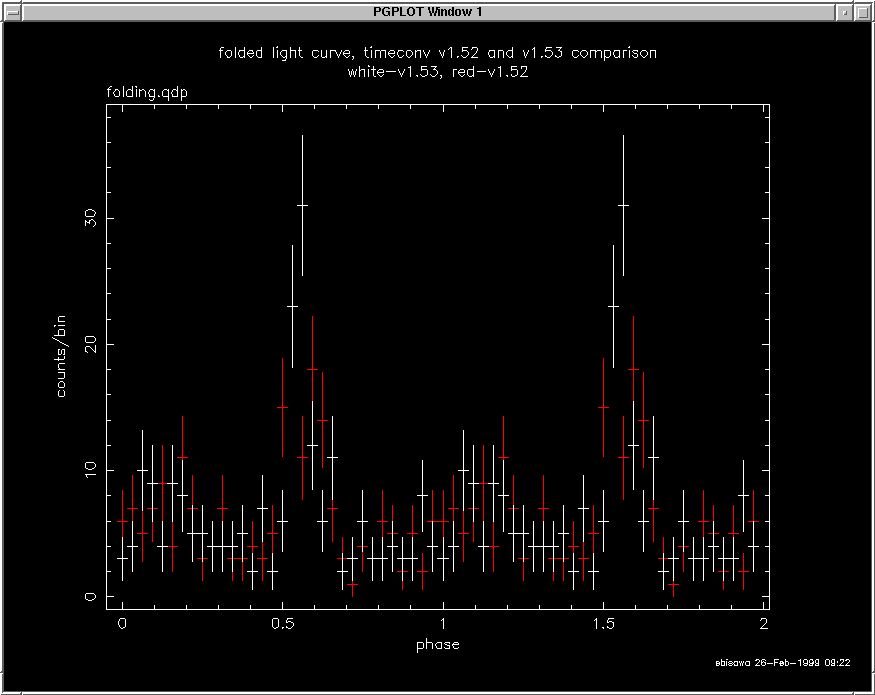► Japanese
► DARTS of the Month

Figure 1: X-ray image around the Galactic center taken during the
ASCA slew observations. The leap seconds are already taken into account in the attitude determination.

Figure 2: Folded light-curve of the 1.6 msec pulsar PSR 1937+21 observed with ASCA.
The red curve is calculated before the leap second correction in the orbit determination,
and the white curve is made after the correction.
Attention! One Minute Will be 61 Seconds!
If you are very punctual, please be careful. Between 2008/12/31 23:59:00 and 2009/01/01 00:00:00 (UT), one minute will be 61 seconds! This is due to the "leap second" to compensate change of the earth rotation speed.
Rate of the earth rotation (spin) is so stable that human being has been using it as a precise "clock". However, recently, we found some atomic properties are more accurate, so that the length of one second is currently defined based on the atomic clock.
Then, if we measure the earth rotation speed with very accurate atomic clock, we found the rate of earth rotation is getting slower (they say the cause is in the earth inner structure). Consequently, from time to time, we need to insert a "leap second" into the time-system based on the atomic clock. The soon-happening leap second insertion will be the 24th since 1972 (the last one was 2006). If no leap seconds had been inserted meanwhile, the atomic clock and the "earth-clock" would have been different by as much as 24 seconds. If these differences are left as they are, eventually, day and night would be flipped!
As a matter of fact, leap seconds will affect scientific satellite data analysis. I will show you two examples in which leap second correction did improved the accuracy (both for the ASCA X-ray satellite). ASCA was operational from 1993 to 2000, during which leap seconds were inserted five times. Namely, if not corrected, five second difference would have arose between the ASCA clock and the "earth-clock". Of course, the X-ray photon arrival time was calculated taking into account the leap seconds. However, the leap second was not taken into account to calculate the ASCA satellite orbit and attitude. It is not because people just forget it, but because people thought ASCA was not capable of such precise observations where very small attitude or orbit changes in several seconds do matter (in fact, ASCA made it!).
In the first example, we show ASCA observation during attitude maneuver (slew). During the period when ASCA carries out large attitude changes, the instrument was kept operational so that "scan" observation was made possible. However, we found the X-ray source positions obtained during the attitude maneuver and the positions in the source catalog have systematic differences. After careful examination, we found the difference is due to the fact that the attitude calculation did not take into account the leap seconds. The position difference was due to the satellite attitude change just within a few seconds. If this attitude shift was corrected, the observed source positions and the catalog positions agreed pretty well (Figure 1). Please find here for more detailed explanation.
Next example is about pulsar observation. The pulsar PSR 1937+21 is rotating at the 1.6 msec period. For such very fast rotating pulsar, we have to measure the pulsation as if being fixed at the gravitation center of the solar system, by removing effects of the satellite and earth orbital motion (barycentric correction). Otherwise, due to the "Doppler effect", we may see a false periodicity or break the true periodicity. In the initial analysis, since satellite orbit calculation did not take into account the leap second, the satellite orbit was inaccurate, and the true period was "smeared". If the leap second was taken into account, we could determine the real pulse profile that is much sharper (Figure 2). Please find here for more detailed explanation.
Ken Ebisawa (C-SODA Science Data Archive Group)
December 2008





